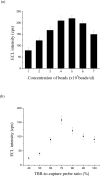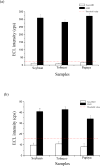PCR-free quantitative detection of genetically modified organism from raw materials. An electrochemiluminescence-based bio bar code method
- PMID: 18386909
- PMCID: PMC5978678
- DOI: 10.1021/ac0713306
PCR-free quantitative detection of genetically modified organism from raw materials. An electrochemiluminescence-based bio bar code method
Abstract
A bio bar code assay based on oligonucleotide-modified gold nanoparticles (Au-NPs) provides a PCR-free method for quantitative detection of nucleic acid targets. However, the current bio bar code assay requires lengthy experimental procedures including the preparation and release of bar code DNA probes from the target-nanoparticle complex and immobilization and hybridization of the probes for quantification. Herein, we report a novel PCR-free electrochemiluminescence (ECL)-based bio bar code assay for the quantitative detection of genetically modified organism (GMO) from raw materials. It consists of tris-(2,2'-bipyridyl) ruthenium (TBR)-labeled bar code DNA, nucleic acid hybridization using Au-NPs and biotin-labeled probes, and selective capture of the hybridization complex by streptavidin-coated paramagnetic beads. The detection of target DNA is realized by direct measurement of ECL emission of TBR. It can quantitatively detect target nucleic acids with high speed and sensitivity. This method can be used to quantitatively detect GMO fragments from real GMO products.
Figures




Similar articles
-
An improved electrochemiluminescence polymerase chain reaction method for highly sensitive detection of plant viruses.Anal Chim Acta. 2007 Jan 23;582(2):275-80. doi: 10.1016/j.aca.2006.09.021. Epub 2006 Sep 16. Anal Chim Acta. 2007. PMID: 17386503
-
Ultrasensitive aptamer-based bio bar code immunomagnetic separation and electrochemiluminescence method for the detection of protein.Anal Chim Acta. 2012 May 6;725:39-43. doi: 10.1016/j.aca.2012.03.006. Epub 2012 Mar 14. Anal Chim Acta. 2012. PMID: 22502609
-
Nanoparticle based bio-bar code technology for trace analysis of aflatoxin B1 in Chinese herbs.J Food Drug Anal. 2018 Apr;26(2):815-822. doi: 10.1016/j.jfda.2017.11.003. Epub 2017 Dec 6. J Food Drug Anal. 2018. PMID: 29567253 Free PMC article.
-
Advances in molecular techniques for the detection and quantification of genetically modified organisms.Anal Bioanal Chem. 2008 Oct;392(3):347-54. doi: 10.1007/s00216-008-1868-4. Epub 2008 Feb 2. Anal Bioanal Chem. 2008. PMID: 18239909 Review.
-
PCR technology for screening and quantification of genetically modified organisms (GMOs).Anal Bioanal Chem. 2003 Apr;375(8):985-93. doi: 10.1007/s00216-003-1767-7. Epub 2003 Feb 15. Anal Bioanal Chem. 2003. PMID: 12733008 Review.
Cited by
-
PCR-free detection of genetically modified organisms using magnetic capture technology and fluorescence cross-correlation spectroscopy.PLoS One. 2009 Nov 26;4(11):e8074. doi: 10.1371/journal.pone.0008074. PLoS One. 2009. PMID: 19956680 Free PMC article.
-
Optimised padlock probe ligation and microarray detection of multiple (non-authorised) GMOs in a single reaction.BMC Genomics. 2008 Dec 4;9:584. doi: 10.1186/1471-2164-9-584. BMC Genomics. 2008. PMID: 19055784 Free PMC article.
-
Ligand synthesis and passivation for silver and large gold nanoparticles for single-particle-based sensing and spectroscopy.Methods Mol Biol. 2013;1025:237-50. doi: 10.1007/978-1-62703-462-3_18. Methods Mol Biol. 2013. PMID: 23918342 Free PMC article.
-
Label-free electrochemical detection of the specific oligonucleotide sequence of dengue virus type 1 on pencil graphite electrodes.Sensors (Basel). 2011;11(6):5616-29. doi: 10.3390/s110605616. Epub 2011 May 26. Sensors (Basel). 2011. PMID: 22163916 Free PMC article.
-
Detection of Helicobacter pylori in dental plaque using a DNA biosensor for noninvasive diagnosis.RSC Adv. 2018 Jun 8;8(38):21075-21083. doi: 10.1039/c8ra03134g. eCollection 2018 Jun 8. RSC Adv. 2018. PMID: 35539942 Free PMC article.
References
-
- Saiki RK, Scharf S, Faloona F, Mullis KB, Horn GT, Erlich HA, Arnheim N. Science. 1985;230:1350–1354. - PubMed
-
- Stiriba SE, Frey H, Haag R. Angew Chem, Int Ed. 2002;41:1329–1334. - PubMed
-
- Dubus S, Gravel JF, Drogoff BL, Nobert P, Veres T, Boudreau D. Anal Chem. 2006;78:4457–4464. - PubMed
-
- Sheila R, Nicewarner-Pena R, Freeman G, Reiss BD, He L, Peña DJ, Walton ID, Cromer R, Keating CD, Natan MJ. Science. 2001;294:137–141. - PubMed
-
- Kerstin K, Paola G, Bohao L, Mario A, Åsa B, Henrik B, Agnès C, Sabine D, Klaus D, Johanna E, Thomas E, Tatiana F, Michael G, Adrian Ho, Sandra J, Markus L, Erik L, Per T, Holger W, Rudolf R. Nucleic Acids Res. 2003;31(16):e89. - PubMed
Publication types
MeSH terms
Substances
Grants and funding
LinkOut - more resources
Full Text Sources
Other Literature Sources

